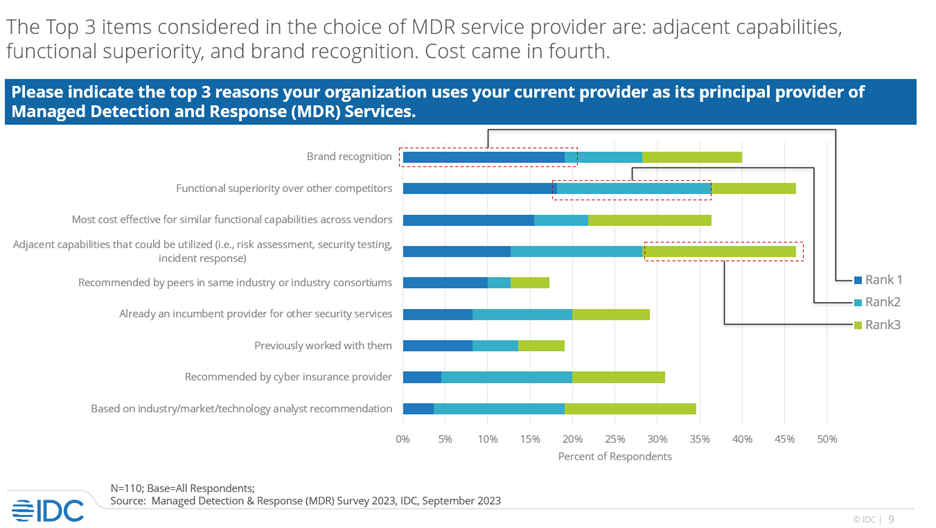To maintain a competitive edge, customers in Latin America are embracing co-managed security solutions, consolidation projects, and cost-efficiency goals. These additional reasons for selecting Managed Detection and Response Services are becoming more and more important.
Are you wondering, what to focus on when it comes to security in the era of Gen AI?, if so, you might be interested in the top 3 reasons for selecting Latin America Managed Detection and Response (MDR) Services, Let’s read more about it.
Well, before thinking it’s better to be alone than in bad company, let’s consider some criteria that could help you to save budget and avoid tough questions from board members.
Have you thought about the top 3 reasons for your organization to select Managed Detection and Response (MDR) Services?
According to respondents, in our latest IDC Latin America: Managed Detection and Response (MDR) Survey, (who were qualified in three waves of rankings), the top 1 in each wave are as follows:

- 1st: Brand Recognition, this could be interpreted as how well-known the company is in the security service provider market ecosystem, but resist the temptation and focus on their trust, reputation, transparency, and ethics.
” Breaches happen to everyone, and some may fall but remember, transparency builds trust”, Emanuel Figueroa.
- 2nd: Functional superiority over other competitors, a service provider must be able to achieve the security outcomes desired by the organization, and this is directly related to the timing in the detection and response lifecycle, capabilities in terms of integration to existing ecosystems, and reporting power.
“If they are able to customize their operations to your environment or industry, that means superiority, not just talking about technology features”, Emanuel Figueroa.
- 3rd: Adjacent capabilities that could be utilized, as security initiatives are always a clean canvas, you must take into consideration that a service provider who could offer advice on how particularly resolve your needs and a robust security offering could reduce the friction caused by areas like purchasing, change management, IT, internal auditing, and risk management and of course finance.
…. But what about cost-effectiveness?
Well, IDC has seen the CISO environment grow in importance to the business, but the more the C-suite gets involved, the more questions CISOs receive about budget efficiency, and the back-and-forth to save resources each year remains one of the biggest challenges.
1 in 3 organizations completely outsource their security tools, with the most challenging tools preferred.
In our recent Managed Detection and Response (MDR) survey, we found that organizations are not only systematically benchmarking direct pricing but also comparing feature sets and costs across vendors (see Figure 1).
IDC knows that all organizations are different – some prefer flexibility over predictability – but we recommend understanding the pricing model, scalability, and time to value before making a decision.
Finally, how do you achieve efficiency and transparency, and manage risk to a level that is acceptable to the board?
By efficiency, we mean increasing operational efficiencies; the faster you and your vendor can resolve issues, detect future incidents, and contain/stop them before they disrupt vital services, the more efficient security will be and the more cyber resilient you will become.
“Security outcomes must meet your specific needs, remain relevant, and be actionable.”
Other efficiencies include reducing the amount of time your staff spends troubleshooting, reporting changes, or requesting adjustments; the more self-service you implement, the more you improve staff productivity and security analyst workload/alert fatigue.
Keep in mind that a large stack of on-premises and cloud assets may require the same level of protection, so automated responses will help your initiatives succeed, and in some cases will require flexibility from the MDR service provider to scale at your pace.
In terms of transparency, look for service providers that can inherit compliance but also can demonstrate privacy and data residency according to your needs, in terms of technical support, look for providers that can supply interfaces with other customers, especially within your industry peers and consortia; this will enhance your experience and help you understand how well they can integrate into your existing environment.
In terms of risk management, ask your service provider how their service is going to improve your security posture, is there any technology that will help you profile your current and future risk exposure, analytics, incident management and threat hunting alone are features,
Is there a risk management report that could add value to your risk management process? Do they present their findings in business terms?
Key takeaways
- Assess your MDR needs and opportunities; requesting proof of value can help you address your use cases and determine criteria for appropriate evaluation.
- Review the IDC Market Glances to understand the competitor’s landscape in the managed security services of Latin America.
- If you are interested in understanding the vendors’ opinions, feel free to reach out, and do not hesitate to ask them who managed security service providers are better prepared or acknowledged.




